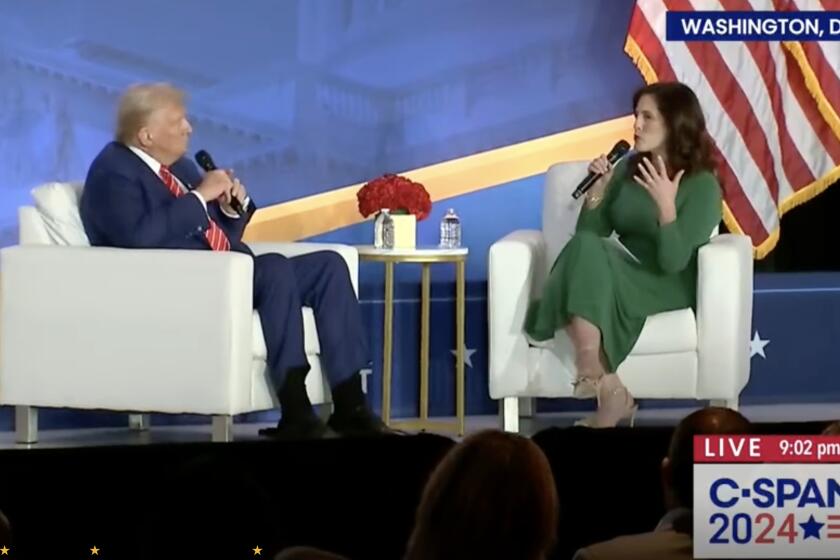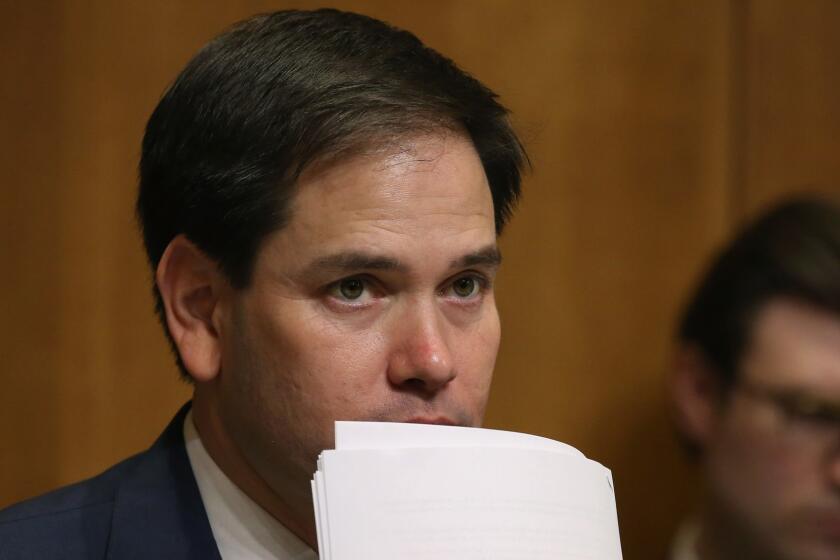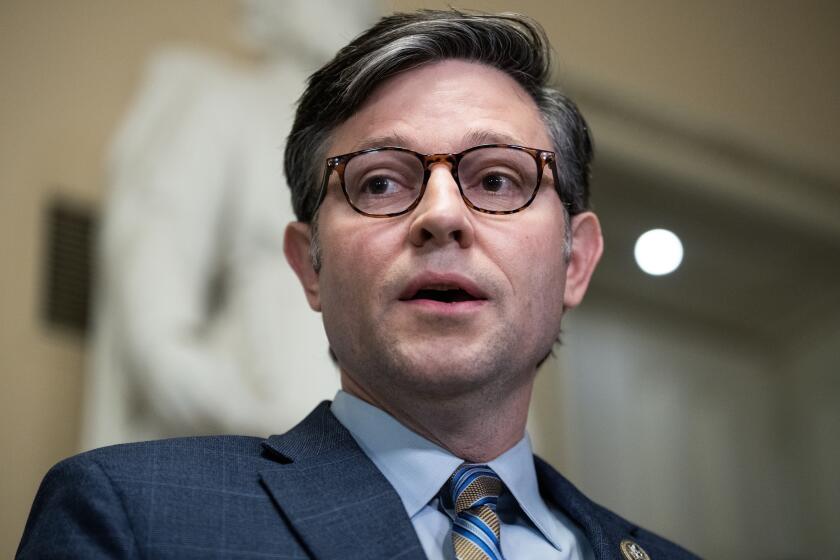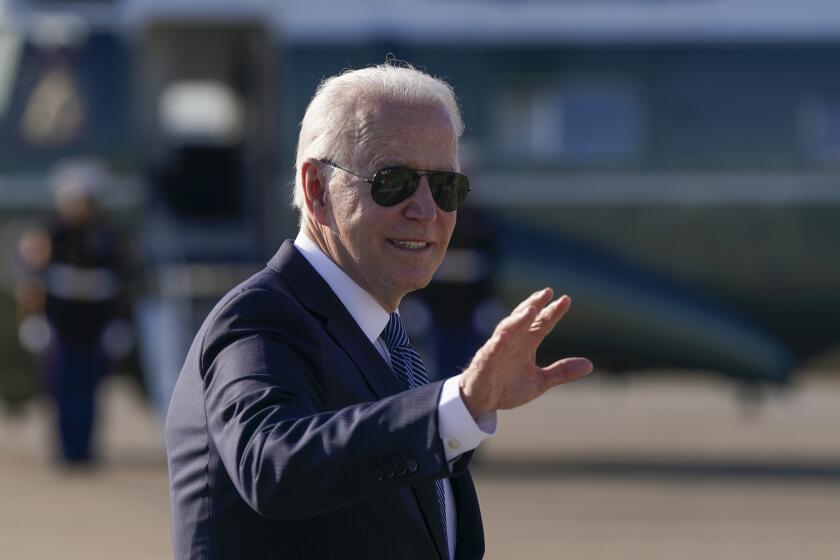Column: I know what Trump was really talking about in his child care rant, and it’s even scarier than you thought
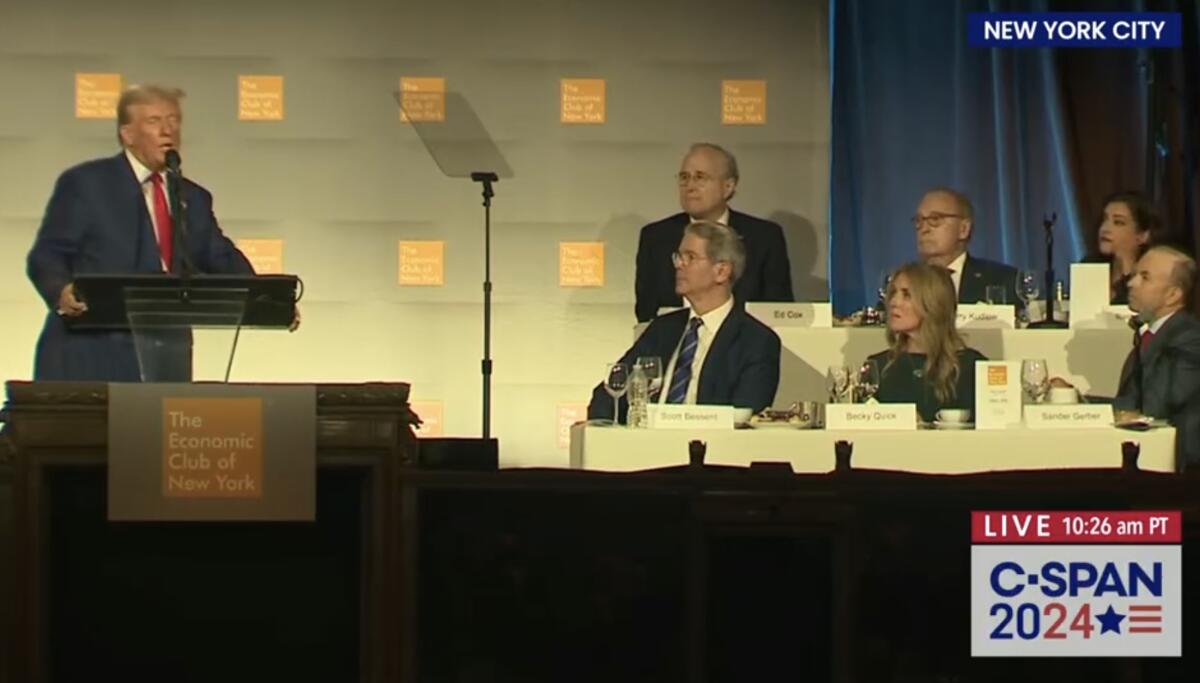
- Share via
An incoherent rant Donald Trump delivered at an appearance Thursday in answering a question about child care policy has gone viral, mostly because it reached new heights of incoherence, even for him.
But what commentators and viewers have missed is the tiny nugget of actual fact nestled within Trump’s 374 words of absolute gibberish. That’s too bad, because that nugget makes his answer even dumber, and scarier, than you might have imagined.
Here’s how he launched into the topic at the Economic Club of New York, when asked by attendee Reshma Saujani, a Democratic children’s advocate, if he would commit to making child care more affordable and what “specific piece of legislation” he would advance as president to do so:
“Well, I would do that, and we’re sitting down, and I was, somebody, we had Sen. Marco Rubio, and my daughter Ivanka was so, uh, impactful on that issue. It’s a very important issue. But I think when you talk about the kind of numbers that I’m talking about, that, because, look, child care is child care is. Couldn’t, you know, there’s something, you have to have it — in this country you have to have it.”
His response? Incomprehensible at best; at worst, outrageously offensive to the millions of families drowning in costs.
— Reshma Saujani, who asked Trump the question about child care that produced his blithering answer
Trump then veered into talking about “taxing foreign nations at levels that they’re not used to,” and about making “this into an incredible country that can afford to take care of its people, and then we’ll worry about the rest of the world,” etc., etc. (Here’s a full, unedited, verbatim transcript.)
Get the latest from Michael Hiltzik
Commentary on economics and more from a Pulitzer Prize winner.
You may occasionally receive promotional content from the Los Angeles Times.
Pretty much everyone writing about this moment has passed over Trump’s references to Rubio (R-Fla.) and to his own daughter Ivanka, probably because they seemed to come completely out of left field.
But they’re an important clue to what was really going through Trump’s mind. In 2018, you see, Rubio and Ivanka actually put forward a proposal for paid family leave.
Donald Trump claims that schools are subjecting pupils to gender-changing surgery without their consent, which is his exclusive fantasy.
It was a horrible idea with a veneer of practicality. It looked like an answer to an issue facing new families, but in fact it would undermine their financial position for life.
The idea was to allow new parents, including adoptive parents, to receive up to 12 weeks of paid family leave. That sounds pretty good so far: The idea of paid family leave was (and is) enormously popular with voters, and providing it to American families would finally bring the U.S. into line with every other high-income nation in the world.
But in the proposal by Rubio and Ivanka Trump, families would have to raid their Social Security to pay for it by reducing or delaying their retirement benefits. As the Urban Institute calculated, for every 12-week leave, new parents would have to delay their Social Security benefits by more than twice that period, or as much as six months.
Parents who took four 12-week leaves, according to this analysis, would lose 10% of their retirement benefits, for life.
Based on the average benefit retirees receive this year, that would mean a hit of nearly $200 a month, taken at a time when many have few other financial resources if any: About 40% of retirees depend on Social Security for half their income or more, and for as many as 15%, Social Security represents 90% of their income.
Deferring retirement benefits, the Urban Institute observed, could “create financial hardship for people who develop health problems or lose their jobs as they approach retirement.”
As I wrote at the time, the dirty little secret of the proposal was the impact it would have on the Social Security system itself. The Rubio-Trump plan fit perfectly into the Republican Party’s long-term project to undermine Social Security.
The leave program would run a deficit every year until it stopped paying benefits to the last claimant — and Social Security would bear the burden of that deficit. That’s because the system would pay out benefits now but not be repaid for 30 years or so. In 2050, for example, the system would pay out an estimated $4 billion in benefits but receive only $2 billion in repayments.
The biggest question was why Social Security needed to be part of a parental leave program at all. The Urban Institute pegged the cost of parental leave at $7.2 billion to $15 billion in 2025, depending on the level of participation.
That’s money that could be found in the government’s seat cushions. Indeed, it could have been paid for by eliminating just some of the tax cuts handed over to the wealthy in the tax package Republicans passed in 2017, which have been estimated to cost at least $1.5 trillion over 10 years, or an average of $150 billion a year — in other words, about 10 times the maximum annual cost of parental leave.
The idea of government-sponsored paid family leave is gaining popularity at the state level and in Washington, where Sen.
The real goal of using parental leave to erode Social Security itself was evident from the proposal’s genesis. Rubio and Ivanka Trump based it on a plan put forward by conservative economic think-tankers Andrew Biggs and Kristin Shapiro. They designed their plan to be “budget neutral” — that is, sparing wealthy taxpayers from shouldering the cost of a program that would have broad benefits for the entire country.
As Biggs and Shapiro wrote, “Social Security is premised on the assumption that it is more important for workers to have their money when they are older than when they are younger. But many new parents understandably might decide that having 12 weeks of paid leave to care for their new child is worth a short deferral of their retirement benefits.”
They claimed that every 12-week leave would require only a six-week retirement deferral, a calculation the Urban Institute demolished.
The worst aspect of the plan was that it fostered the impression of Social Security as a piggy bank, to be drawn down for any conceivable financial hardship — to buy a house, repay student loans, and so on. Once the first one of these plans is enacted, you can be sure that others will follow, until there’s almost nothing left of Social Security’s guarantee of a living income in retirement.
So what happened Thursday at Trump’s appearance? It seems evident that he dredged up, from the distant, dim recesses of his mind, that Rubio and Ivanka once had a proposal that was “impactful” on child care, whatever that means.
He doesn’t know anything about it, so of course he got it wrong. Their plan was for paid parental leave, to tide families over only for the first two or three months of parenthood. It had nothing to do with what Saujani asked, which was how to help families with the cost of child care that can extend into a child’s adolescence.
Fiscal hawks love to claim that America is shortchanging its youth by spending so much to support its seniors. But the real economic war is between the rich and everyone else -- and the rich are winning.
Saujani, by the way, didn’t think much of Trump’s response, which she called “incomprehensible at best; at worst, outrageously offensive to the millions of families drowning in costs.”
It’s worth noting that Trump’s utter failure to grasp the reality of child care in America dovetails precisely with the approach of his running mate, JD Vance.
On Wednesday, asked about the cost of day care during an appearance before the right-wing organization Turning Point USA, Vance argued that it was the responsibility of a couple’s extended family.
“Maybe Grandma and Grandpa wants to help out a little bit more,” he said. “Or maybe there’s an aunt or uncle that wants to help out a little bit more.”
For families without grandparents or aunts and uncles who are no longer with us, or don’t live nearby, or have other things to do — or maybe are even psychotics that parents don’t wish to have near their children — Vance’s solution is to reduce educational or certification requirements so that more people can enter the day care business.
Of course, this is part and parcel of the Republican drive to deregulate everything. In 2019, the Trump administration cut back on USDA inspections of meat plants, promoting a self-inspection regime for the industry.
How has that worked out? At this moment, at least nine people have died from a listeria outbreak at a Boar’s Head deli meats plant in Virginia, where conditions were, to be charitable, disgusting. Apply the same principle to day care, and contemplate the ramifications.
The bottom line is that Trump and Vance have no practical ideas about how to relieve the burden of child care expenses on American families. Their goal is that whatever the answer, the government won’t pay for it.
This isn’t the “ownership society” that Republicans as recently as George W. Bush proclaimed; it’s the “you’re on your own” society. Trump’s words Thursday may have been incoherent, but his point was crystal clear.
More to Read
Get the latest from Michael Hiltzik
Commentary on economics and more from a Pulitzer Prize winner.
You may occasionally receive promotional content from the Los Angeles Times.

